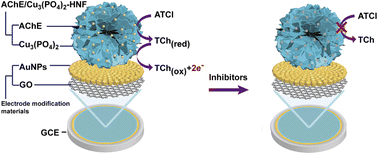Acetylcholinesterase–Cu3(PO4)2 hybrid nanoflowers for electrochemical detection of dichlorvos using square-wave voltammetry†
Abstract
Immobilization of enzymes is one of the key steps in the development of high-performance enzymatic electrochemical biosensors, and various nanostructured materials have been designed and developed to achieve this goal. Herein, hybrid nanoflowers (HNFs) were synthesized using acetylcholinesterase (AChE) as an organic component and copper phosphate (Cu3(PO4)2) as an inorganic component. These AChE–Cu3(PO4)2 HNFs exhibit a three-dimensional hierarchical flower-like structure, which not only has a large specific surface area but also promotes the affinity between AChE and its substrate with better catalytic activity. Not only that, the surface modification of the glassy carbon electrode (GCE) by the joint use of gold nanoparticles (AuNPs) and graphene oxide (GO) extended the electroactive area. Using square-wave voltammetry (SWV), the as-prepared biosensor (i.e., AChE–Cu3(PO4)2 HNF/AuNP/GO/GCE) demonstrated superior sensing performance in the detection of dichlorvos. The detection limit is as low as 0.07 pM, and the linear detection range can range from 0.5 pM to 10 μM. In addition, the biosensor was feasible in real agricultural samples with satisfactory recoveries (98.65% to 103.43%). The reported biosensor provides an alternative tool for the direct measurements of AChE activity and its inhibition. Besides organophosphorus pesticides represented by dichlorvos, this biosensor has the potential to detect other AChE inhibitors, such as carbamate pesticides, drugs for Alzheimer's disease, etc., thus having broader applications in food safety and drug screening.



 Please wait while we load your content...
Please wait while we load your content...